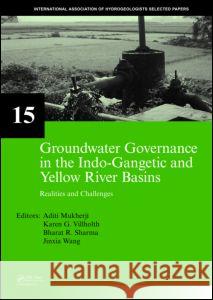Groundwater Governance in the Indo-Gangetic and Yellow River Basins: Realities and Challenges » książka
Groundwater Governance in the Indo-Gangetic and Yellow River Basins: Realities and Challenges
ISBN-13: 9780415465809 / Angielski / Twarda / 2009 / 348 str.
Groundwater Governance in the Indo-Gangetic and Yellow River Basins: Realities and Challenges
ISBN-13: 9780415465809 / Angielski / Twarda / 2009 / 348 str.
(netto: 1022,01 VAT: 5%)
Najniższa cena z 30 dni: 1007,48
ok. 22 dni roboczych.
Darmowa dostawa!
One of the key features of agricultural development in the last five decades has been intensive groundwater use in the Indo-Gangetic Basin (Pakistan, India, Nepal and Bangladesh) and in the Yellow River Basin (China). Groundwater irrigates almost 60% of the net irrigated area in South Asia and 70% in the north China plains. Groundwater use for agriculture is still increasing. Despite the growing significance of groundwater to agricultural growth, food security and rural livelihoods globally, and at the same time significant signs of limitations and constraints for further use, knowledge of the subject has remained limited. The subject includes the wider issues of socioeconomic impacts, political economy, groundwater institutions, access to other resources like energy and land, approaches to resource governance and management and specifically integrating evidence-based science into management decisions. This book addresses these information shortfalls and provides a consolidated and cross-disciplinary source of information and documentation of realities and challenges of contemporary agricultural groundwater use and management in poverty-prone areas of Asia. It draws on primary data collected in the course of an innovative, cross-coordinated and inter-disciplinary fieldwork programme, covering those regions in Asia that significantly depend on groundwater for agricultural livelihoods. This work is essential reading for hydrogeologists, socio-economists, agro-economists and water managers working in poor countries. Donors and implementers, both government and NGO, will also learn from the experiences described in this book.
One of the key features of agricultural development in the last five decades has been the intensive groundwater use in the Indo-Gangetic Basin (IGB) (Pakistan, India, Nepal and Bangladesh) and the Yellow River Basin (YRB) (China). For instance, in South Asia, groundwater irrigates almost 60% of the net irrigated area, this figure is even higher in the north China plains, near 70%. There is evidence to show that groundwater use for agriculture is still on the rise. Despite the growing significance of groundwater to agricultural growth, food security and rural livelihoods globally, the literature and understanding of the subject has remained small and lop-sided. Groundwater models and location-specific hydro-geological analyses abound; but larger issues of socio-economic impacts, political economy, groundwater institutions, property rights, and approaches to resource governance and management and specifically integrating science into management decisions have attracted surprisingly little scientific interest.
This book is designed to at least partially address these information shortfalls and provide a consolidated and cross-disciplinary source of information and contemporary thinking on agricultural groundwater use and management in poverty-prone areas of Asia. The editors and contributors are drawn from a wide range of academic disciplines from both the physical and social sciences. Most of the authors are groundwater professionals working in groundwater or related departments in their respective countries and they bring in a wealth of location-specific experience and expertise. Most of the chapters in this book rely heavily on primary data collected by the authors in the course of an innovative, cross-coordinated and inter-disciplinary fieldwork exercise, covering areas across the regions that significantly depend on groundwater for agricultural livelihoods.











